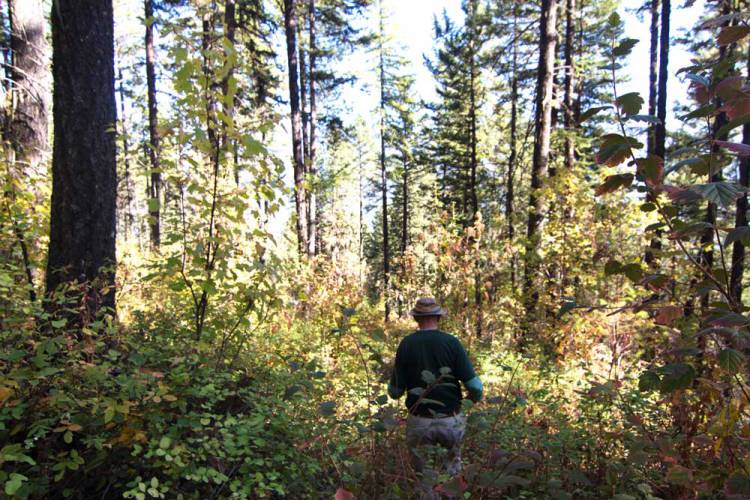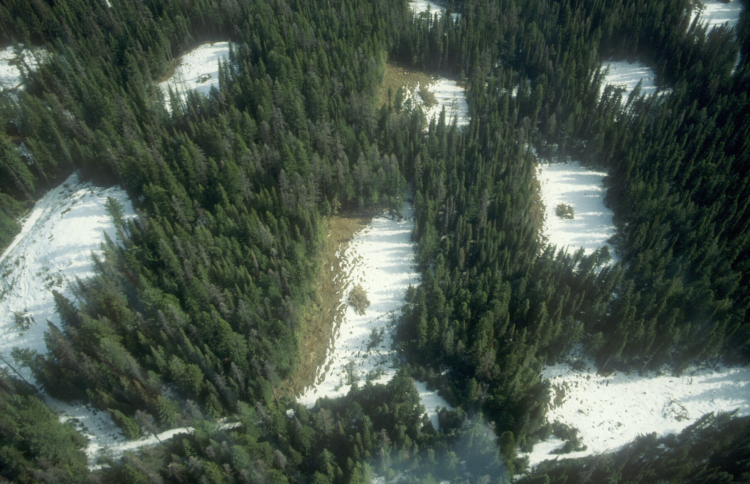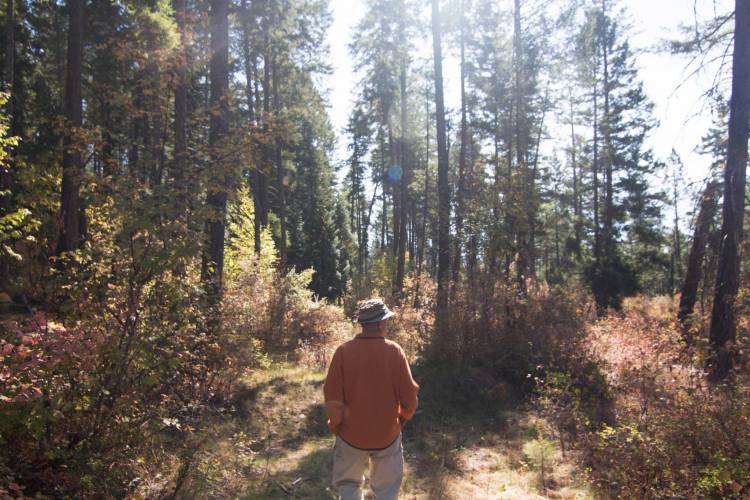I’m behind a quick moving Jim Smith as we work our way through thick alder and saskatoon. He’s spent his life in the bush and seems to move faster as the brush gets thicker. Jim, a retired forester with over 30 years of experience, has brought me to Goat Mountain to give me a field tour of his work in the Creston Community Forest.
The Creston Community Forest operates on 210 square kilometers of land surrounding the Creston Valley. Jim’s work here is an example of best management practices carried out by the people who live and work in their watershed. They rely on the very water that flows down from the western edge of the Purcell Mountains into the Creston Valley. Ultimately it’s that connection to place, the knowledge of and reliance on an ecosystem that makes this type of community based forestry sustainable.

Site 1: Group Selection – Interspersed ⅓ hectare clearcuts over a 70 ha. area
The forest here is extremely diverse with various ages and sizes of douglas fir, larch, cedar, grand fir, hemlock, lodgepole pine, western white pine, and deciduous trees. Jim tells me that the method of harvest used at this site helps protect watershed health. Small clearcut openings are dispersed over a 70 hectare area, mimicking natural stand openings. The ⅓ hectare meadow-like openings are small enough to retain water and disperse runoff throughout the year, as opposed to large openings or clearcuts that increase surface flow runoff and can increase the risk of flooding and impact water quality.

Forests essentially operate as a sponge—soaking up water during the spring runoff and retaining water during periods of drought. With climate change, precipitation patterns are changing. Extreme weather and disturbance events like drought, fire and flooding are already occurring with greater intensity. Pest and insect epidemics like mountain pine beetle and spruce bark beetle infestations are already having a strong impact on our forests. Having healthy, biodiverse, resilient forests that can withstand extreme disturbance events like fire, flood, and insect infestations will be key to forest and ecosystem health. Jim’s prescribed harvesting at this site has retained the biodiversity and health of this forest, making it resilient in the face of a changing ecosystem.
Site 2: Selective Conventional Harvesting – 20-30m basal area.
“It’s hard to tell that this forest has been logged,” I say to Jim as we walk past an old larch snag riddled with woodpecker nesting cavities. Jim informs me that this forest has been logged twice in the last twenty years. More than a third of the trees have been removed; yet apart from the odd stump and not yet fully grown-in skid trails, you’d hardly know the area had been logged. The machine operators and logging crew here did an incredible job leaving a diverse and varied forest canopy with almost no soil disturbance. Fresh deer and elk scat is found throughout the block. The area is high quality winter habitat for ungulates—clumps of big fir trees provide snow interception and winter forage in heavy snow years. This forest is an example of a working forest that has had some parts removed, while still preserving the integrity of the whole.

Using the “Precautionary Principle”
During his time as a prescribing forester, Jim always exercised “the precautionary principle” because there are so many uncontrollable variables. A large natural disturbance like a catastrophic wildfire or flood could take place after logging, drastically increasing sedimentation and erosion risk. With climate change, these events are predicted to occur with greater frequency and/or intensity. A precautionary approach to forestry and resource management is needed as we don’t fully understand the impact that a changing climate and ecosystem will have on our regions forests, streams, and wildlife.
Keeping All The Parts
Forests are complicated. Increasingly, science is showing us how forests actually operate. In the recent book, The Hidden Life of Trees, forest scientist Peter Wohlleben explains that natural forests have evolved over thousands of years and have developed complex relationships with all of their parts. Whether it’s complex fungi interactions of tree roots that work together to share nutrients or a dying Douglas Fir that will heroically share carbon with a Ponderosa Pine, we are now just beginning to understand how a naturally functioning forest operates. These functioning forests have taken thousands of years to evolve and their complex interactions and communication systems cannot be replanted. The current industrial scale of forestry doesn’t allow these processes to take place because they are predicated on removing most or all of the parts of a forest and replanting with genetic stock.
There’s no doubt that Jim’s community forest approach to harvesting substantially alters the forest and landscape. But this ecosystem-based approach mitigates impact on the forest and the ecosystem. Jim’s work here in the Creston Community Forest is an example of best management practices being implemented by people who work in and love the place where they live. In the long run, this ecosystem-based approach to forestry keeps all of the complex and integral parts of a forest together.



